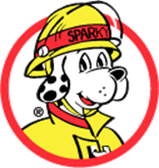
More than 15,925 people were injured by fire in the United States in 2013, according to the U.S. Fire Administration. If a fire breaks out in your home, you may have as little as two minutes to safely escape once the alarm sounds.
Planning can help protect you, your family, and your home when seconds count.
Here are a few steps to help keep your family fire safe:
· Check that all smoke alarms are working properly;
· Make a map of your home and mark all windows and doors through which you may escape;
· Choose a meeting place outside the home where firefighters can see you and your family;
· Write the emergency telephone number for your fire department on your escape plan;
· Practice your fire escape drill; and
· Keep your fire escape plan in a common area where everyone can see it, i.e. refrigerator.
For more information about protecting your family and developing a fire escape plan, check out the home fire escape materials from the U.S. Fire Administration.
Portable Fireplaces: Tips for Staying Cozy and Safe
Portable fuel-burning fireplaces have become a popular way for people to heat their homes during winter months. However, if not used properly, these devices can be dangerous and pose a serious fire hazard.
According to the National Fire Protection Association (NFPA), half of all home heating fires occur in December, January, and February. Learn how to “Put a Freeze on Winter Fires.” Before you snuggle up to a portable fireplace, keep these NFPA safety tips in mind:
· Make sure the fireplace has an Underwriters’ Laboratory (UL) listing. This ensures the product has been tested for safety;
· Read and follow the manufacturer’s instructions closely;
· Keep the area where you're using the fireplace well ventilated;
· Do not use the fireplace in sleeping areas; and
· Light the fireplace using a utility lighter or long match.
As with all heating equipment, space is important! Create a “safe zone” around the device by keeping children, pets, and anything that can burn at least three feet away.
To find out more information and protection tips on portable fireplaces, go to the NFPA website.
Planning can help protect you, your family, and your home when seconds count.
Here are a few steps to help keep your family fire safe:
· Check that all smoke alarms are working properly;
· Make a map of your home and mark all windows and doors through which you may escape;
· Choose a meeting place outside the home where firefighters can see you and your family;
· Write the emergency telephone number for your fire department on your escape plan;
· Practice your fire escape drill; and
· Keep your fire escape plan in a common area where everyone can see it, i.e. refrigerator.
For more information about protecting your family and developing a fire escape plan, check out the home fire escape materials from the U.S. Fire Administration.
Portable Fireplaces: Tips for Staying Cozy and Safe
Portable fuel-burning fireplaces have become a popular way for people to heat their homes during winter months. However, if not used properly, these devices can be dangerous and pose a serious fire hazard.
According to the National Fire Protection Association (NFPA), half of all home heating fires occur in December, January, and February. Learn how to “Put a Freeze on Winter Fires.” Before you snuggle up to a portable fireplace, keep these NFPA safety tips in mind:
· Make sure the fireplace has an Underwriters’ Laboratory (UL) listing. This ensures the product has been tested for safety;
· Read and follow the manufacturer’s instructions closely;
· Keep the area where you're using the fireplace well ventilated;
· Do not use the fireplace in sleeping areas; and
· Light the fireplace using a utility lighter or long match.
As with all heating equipment, space is important! Create a “safe zone” around the device by keeping children, pets, and anything that can burn at least three feet away.
To find out more information and protection tips on portable fireplaces, go to the NFPA website.

 RSS Feed
RSS Feed